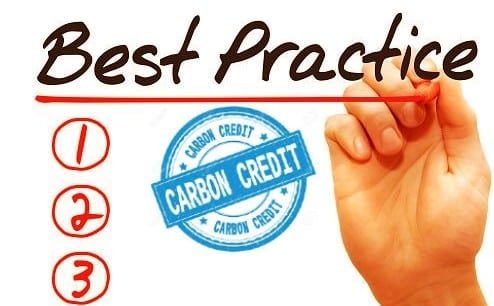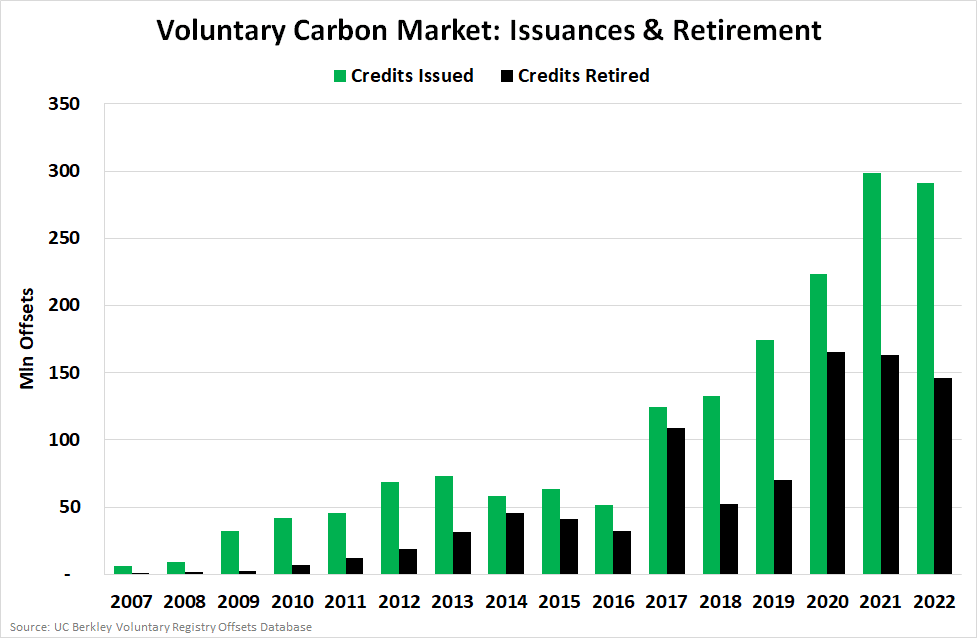The trading of carbon credits can help entities and the world meet their climate goals by cutting carbon emissions and practicing sustainable business. While some companies have various means to get rid of their footprint, many simply don’t have any at their disposal. And so using carbon credits is a necessity for them.
But how can carbon credits help promote the best practices that ensure the future of sustainable business? How can they be instrumental in advancing both corporate sustainability and global sustainable development?
This article will explain how by looking into best practices that can scale up the voluntary carbon market and help businesses achieve their climate change goals.
Companies Ally in Conquering Climate Change
The number of businesses pledging to help put an end to climate change by slashing their own GHG emissions continues to grow. Yet many of them find that they cannot fully get rid of their emissions, or even reduce them as fast as they may like.
The challenge is particularly tough for entities with net zero emissions targets, meaning removing as much carbon as they emit. For them, it helps to use carbon credits to offset emissions they can’t eliminate by other means.
Voluntary carbon credits, also known as carbon offsets, are bought by companies for reasons other than compliance. These market instruments help direct private financing to climate-related projects and initiatives that won’t otherwise be developed or take off. More importantly, these projects also offer added benefits beyond just carbon reduction like job creation and biodiversity conservation.
Carbon credits also have the potential to bring down the cost of emerging climate technologies by providing startups enough capital. And most importantly, this market tool can help drive investments to places where nature-based emissions reduction projects are most viable.
How Can Carbon Credits Help Companies Reach Their Climate Goals?
Achieving climate goals seems to be the finish line among organizations these days. But what does it really mean?
Collectively, that means limiting the rise in global temperatures to 2.0°C above pre-industrial levels, and ideally 1.5°C. Putting that in context, it means cutting global GHG emissions by 50% of current levels by 2030 and bringing them to net zero by 2050.
More and more businesses are aligning themselves with this global sustainable development agenda. In fact, the number of companies with net zero climate commitments doubled in less than a year – from 500 (2019) to 1,000 (2020).
Among those businesses, reducing carbon emissions to be carbon neutral or net zero has major limitations. For instance, a big part of the pollution of companies operating in the cement industry comes from processes they simply can’t just stop.
So, how can they reduce their emissions without stopping their business operations? By buying carbon credits.
- Carbon credits work like permissions allowing holders the right to emit a certain amount of carbon under the compliance market. Within the VCM, carbon credits represent the corresponding quantity of carbon that has been reduced or removed by an initiative.
Remember that each carbon credit is equal to one tonne of carbon removed or prevented from entering the atmosphere.
Carbon credits have been in use for years now, but their voluntary use has grown immensely only in recent years. As seen in the chart from Katusa Research, buyers have retired (claimed the impact of the credit) about 150 million credits per year since 2020.
And as global efforts to transition to low-carbon and sustainable practices intensify, demand for carbon credits will also grow. Based on industry estimates, annual global demand for carbon credits can go up to 1.5 to 2.0 gigatons of CO2 by 2030 and up to 7 to 13 GtCO2 by 2050.
That also means the VCM size can be between $30 billion and $50 billion by the end the decade, depending on various factors such as price.

Per McKinsey analysis, the supply of carbon credits to meet such projected demand will come from these categories:
- avoided nature loss (including deforestation);
- nature-based sequestration, such as reforestation;
- avoidance or reduction of emissions such as methane from landfills; and
- technology-based removal of carbon dioxide from the atmosphere.
While the future of sustainable business becomes possible through carbon credits, some challenges exist that may prevent VCM’s scale up. If not addressed fully, these roadblocks can bring down supply from 8-12 GtCO2 per year to 1-5 GtCO2.
Key challenges include:
- Most nature-based supply of carbon credits is concentrated in few countries
- Difficulty in attracting enough financing
- Long lag times between capital raising and selling carbon credits
- Carbon accounting and verification methods vary, making supply of high-quality carbon credits
- Some confusions in the definition of the credits’ co-benefits (benefits beyond carbon reductions)
- Long lead times in verifying carbon credits quality, which is crucial to achieve market integrity
- Other problems include unpredictable demand, low liquidity and limited data availability
Though these challenges are indeed daunting, they are not invincible. By adopting best practices in using and integrating carbon credits into climate change mitigation measures, the VCM can help secure the future of sustainable business.
Best Practices to Scale Up the VCM
As we have demonstrated, carbon credits can help promote corporate sustainability by helping companies reach their climate goals. And as most of us know, large companies are the most guilty in dumping carbon into the air.
As long as they are making efforts in cutting their carbon footprint and bringing it to net zero, they can still continue doing business sustainably. But what can these big businesses and other market players do to ensure that the market doesn’t wither but grow?
Here are the top four ways that could further develop the VCM and scale it up for more carbon reductions.
Having Uniform Principles for Carbon Credit Definition and Verification
The market for voluntary carbon credits still lacks ample liquidity to transact efficient trading. What causes this is the fact that the credit attributes vary a lot, affected mostly by the project generating it. The carbon credit price depends on the specific project type and/or its location.
Each project also delivers a different set of benefits and added values, which value varies as well. This attribute makes the process of matching the buyer and seller quite difficult and time-consuming.
- But with uniform features that define or describe the credits, the match-making process would be easier. One of these features would be the quality of the credit.
The recent release of the International Council for the VCM of its “Core Carbon Principles” is a good starting point for both suppliers and buyers to refer to. The principles provided offer a good reference in verifying the carbon reductions claim of the credits.
This is also important when developing reference contracts of carbon credit deals and their corresponding trading prices on the exchanges. In this case, it would make it more efficient for the market to aggregate smaller supplies to match the larger bids of corporate buyers.
Developing Flexible Trading and After-Trade Infrastructure
A well-functioning VCM requires a flexible trading infrastructure. That function is to facilitate high-volume listing and trading of contracts. In effect, this enables the establishment of structured financing for project developers.
The top carbon exchanges often have this infrastructure in place, enabling them to support and help scape up the market.
The same goes for post-trade infrastructure, such as registries and clearinghouses. They must support the creation of futures markets and provide the necessary counterparty default protection.
- Carbon registries, in particular, should be providing necessary services and facilitating the issuance of identification numbers for each project.
These infrastructures can help promote transparency of data and information in the market, and so, increase trust among buyers and sellers alike. This is currently not the case in the VCM as access is limited, making tracking difficult. Issues in transparency are plaguing the market, putting some projects under query and further investigation.
Analytics and reports that put together accessible reference data from various registries, like how APIs do, can help advance transparency. This startup that developed the first API for carbon credits seeks to address this task, aiming to improve transparency.
Building Guidelines for the Correct Use of Credits
Though many companies use carbon credits to offset their emissions, they’re not the automatic option in reducing emissions. Some skeptics said that they deter businesses to offset their footprint instead of reducing them directly. Others argued that they become a tool for greenwashing – claiming to be eco-friendly though the business continue to emit more.
This is why there must be clear and robust principles governing the use of carbon credits to eliminate doubts.
Specifically, offsetting should be an option for emissions that are too difficult to abate. They should not overtake other climate mitigation measures while ensuring more carbon reductions actually happen.
This best practice requires a business to disclose its carbon emissions first and create a baseline for it. From there, carbon reductions targets and strategies will follow. Only by doing so can the company know how much emissions it needs to offset and buy the corresponding credits.
Safeguarding Integrity of the VCM
Same with transparency, the VCM is also facing the issue of integrity. The main culprit is the wide differences in the carbon credits’ nature, making them plausible for fraudulent transactions.
One solution is to have a digital system in place that registers and verifies the credits authenticity before issuance. Verifiers must be able to monitor the project’s impact regularly to confirm their carbon reduction claims.
That won’t just safeguard the integrity of the carbon credits but can also help developers in cutting down associated costs. Digitization translates to standardization that lowers issuance costs while improving offset credibility in corporate climate commitments.
Ultimately, a governing body is critical to enhancing integrity by overseeing market players’ behavior and the overall market functions.
In sum, businesses and other organizations can reduce their carbon footprint by employing clean energy technologies and sources. Still, many need carbon credits to complement their climate change mitigation efforts while aligning them with their corporate sustainability goals.
By following the four best practices identified, a scaled up voluntary carbon credit market can help secure the future of sustainable business.


